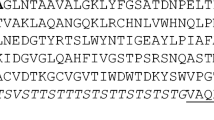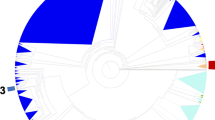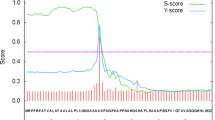Abstract
Xylanases randomly clear the backbone of xylans, which are hemicelluloses representing a considerable source of fixed carbon in nature. Consequently, these enzymes have important industrial applications. To characterize the genes responsible for producing these enzymes, we cloned xylanase genes belonging to the GH11 and GH10 families from Aspergillus versicolor MKU3 using a 2-step polymerase chain reaction (PCR) protocol involving degenerate PCR and genome-walking PCR (GWPCR). We amplified a family 10 xylanase consensus fragment using degenerate PCR primers exhibiting specificity for conserved motifs within fungal family 10 xylanase genes. We identified a single family 10 xylanase gene (xynv10) and determined its entire gene sequence during the second step of GWPCR, which was used to amplify genomic DNA fragments upstream and downstream of xynv10. The xynv10 sequence contains a 1,378-bp open reading frame separated by 8 introns with an average size of 49 bp. We also amplified a partial GH11 xylanase gene sequence (xynv11) using degenerate PCR and genome-walking methods. Amplification of the C-terminal region of xynv11 using a degenerate primer designed from sequences revealed strong homology with the partial GH11 xylanase gene of A. versicolor MKU3. The structural region in xynv11 was approximately 680 bp and has one intron that is approximately 64 bp in length. Further expression and characterization of these genes will give better understanding of the role of these genes in xylan degradation by A. versicolor.
Similar content being viewed by others
References
Morris, D. D., M. D. Gibbs, C. W. J. Chin, M. H. Koh, K. K. Y. Wong, R. W. Allison, P. J. Nelson, and P. L. Bergquist (1998) Cloning of the xynB gene from Dictyoglomus thermophilum Rt46B.1 and action of the gene product on kraft pulp. Appl. Environ. Microbiol. 64: 1759–1765.
Henrissat, B. and A. Bairoch (1996) Updating the sequence- based classification of glycosyl hydrolases. Biochem. J. 316: 695–696.
Kilstrup, M. and K. N. Kristiansen (2000) Rapid genome walking: a simplified oligo-cassette mediated polymerase chain reaction using a single genome-specific primer. Nucleic Acids Res. 28: e55.
Mishra, R. N., S. L. Singla-Pareek, S. Nair, S. K. Sopory, and M. K. Reddy (2002) Directional genome walking using PCR. Biotechniques 33: 830–834.
Nthangeni, M. B., F. Ramagoma, M. G. Tlou, and D. Litthauer (2005) Development of a versatile cassette for directional genome walking using cassette ligation-mediated PCR and its application in the cloning of complete lipolytic genes from Bacillus species. J. Microbiol. Methods 61:225–234.
Salama, M. A., K. M. I. Ismail, H. A. Amany, A. El-Lill, and N. S. I. Geweely (2008) Biochemical studies of purified extracellular xylanases from Aspergillus versicolor. Int. J. Botany 4: 41–48.
Jeya, M., S. Thiagarajan, and P. Gunasekaran (2005) Improvement of xylanase production in solid-state fermentation by alkali tolerant Aspergillus versicolor MKU3. Lett. Appl. Microbiol. 41: 175–178.
Murray, M. G. and W. F. Thompson (1980) Rapid isolation of high molecular weight plant DNA. Nucleic Acids Res. 8: 4321–4325.
Morris, D. D., R. A. Reeves, M. D. Gibbs, D. J. Saul, and P. L. Bergquist (1995) Correction of the β-mannanase domain of the celC pseudogene from Caldocellulosiruptor saccharolyticus and activity of the gene product on kraft pulp. Appl. Environ. Microbiol. 61: 2262–2269.
Altschul, S. F., W. Gish, W. Miller, E. W. Myers, and D. J. Lipman (1990) Basic local alignment search tool. J. Mol. Biol. 215: 403–410.
Reeves, R. A., M. D. Gibbs, D. D. Morris, K. R. Griffiths, D. J. Saul, and P. L. Bergquist (2000) Sequencing and expression of additional xylanase genes from the hyperthermophile Thermotoga maritima FjSS3B.1. Appl. Environ. Microbiol. 66: 1532–1537.
Sunna, A., M. D. Gibbs, and P. L. Bergquist (2000) A novel thermostable multidomain 1,4-β-xylanase from Caldibacillus cellulovorans and effect of its xylanbinding domain on enzyme activity. Microbiology 146: 2947–2955.
Zhang, G. M., J. Huang, G. R. Huang, L. X. Ma, and X. E. Zhang (2007) Molecular cloning and heterologous expression of a new xylanase gene from Plectosphaerella cucumerina. Appl. Microbiol. Biotechnol. 74: 339–346.
Apel-Birkhold, P. C. and J. D. Walton (1996) Cloning, disruption, and expression of two endo-β1,4-xylanase genes, XYL2 and XYL3, from Cochliobolus carbonum. Appl. Environ. Microbiol. 62: 4129–4135.
Kimura, T., N. Kitamoto, Y. Kito, S. Karita, K. Sakka, and K. Ohmiya (1998) Molecular cloning of xylanase gene xynG1 from Aspergillus oryzae KBN 616, a shoyu koji mold, and analysis of its expression. J. Ferment. Bioeng. 85: 10–16.
Sato, Y., Y. Niimura, K. Yura, and M. Go (1999) Module-intron correlation and intron sliding in family F/10 xylanase genes. Gene 238: 93–101.
Kimura, T., H. Suzuki, H. Furuhashi, T. Aburatani, K. Morimoto, K. Sakka, and K. Ohmiya (2002) Molecular cloning, characterization, and expression analysis of the xynF3 gene from Aspergillus oryzae. Biosci. Biotechnol. Biochem. 66: 285–292.
Chavez, R., C. Almarza, K. Schachter, A. Peirano, P. Bull, and J. Eyzaguirre (2001) Structure analysis of the endoxylanases A gene from Penicillium purpurogenum. Biol. Res. 34: 217–226.
Haas, H., E. Friedlin, G. Stoffler, and B. Redl (1993) Cloning and structural organization of a xylanase-encoding gene from Penicillium chrysogenum. Gene 126: 237–242.
Schmidt, A., A. Schlacher, W. Steiner, H. Schwab, and C. Kratky (1998) Structure of the xylanase from Penicillium simplicissimum. Protein Sci. 7: 2081–2088.
Tsukagoshi, N., T. Kobayashi, and M. Kato (2001) Regulation of the amylolytic and (hemi-) cellulolytic genes in aspergilli. J. Gen. Appl. Microbiol. 47: 1–19.
Kimura, T., H. Suzuki, H. Furuhashi, T. Aburatani, K. Morimoto, S. Karita, K. Sakka, and K. Ohmiya (2000) Molecular cloning, overexpression, and purification of a major xylanase from Aspergillus oryzae. Biosci. Biotechnol. Biochem. 64: 2734–2738.
Lubeck, P. S., L. Paulin, Y. Degefu, M. Lubeck, I. Alekhina, S. A. Bulat, and D. B. Collinge (1997) PCR cloning, DNA sequencing and phylogenetic analysis of a xylanase gene from the phytopathogenic fungus Ascochyta pisi Lib. Physiol. Mol. Plant Pathol. 51: 377–389.
Author information
Authors and Affiliations
Corresponding author
Rights and permissions
About this article
Cite this article
Jeya, M., Thiagarajan, S., Lee, JK. et al. Identification of new GH 10 and GH 11 xylanase genes from Aspergillus versicolor MKU3 by genome-walking PCR. Biotechnol Bioproc E 14, 13–19 (2009). https://doi.org/10.1007/s12257-008-0112-6
Received:
Accepted:
Published:
Issue Date:
DOI: https://doi.org/10.1007/s12257-008-0112-6




